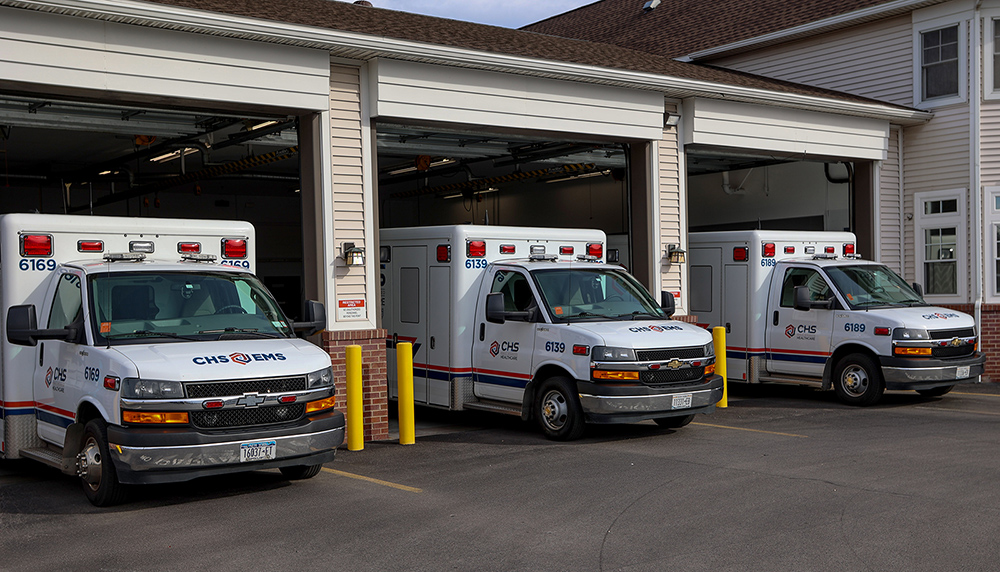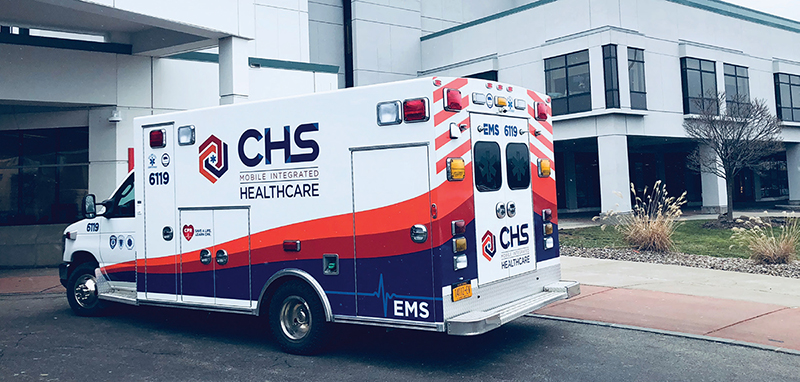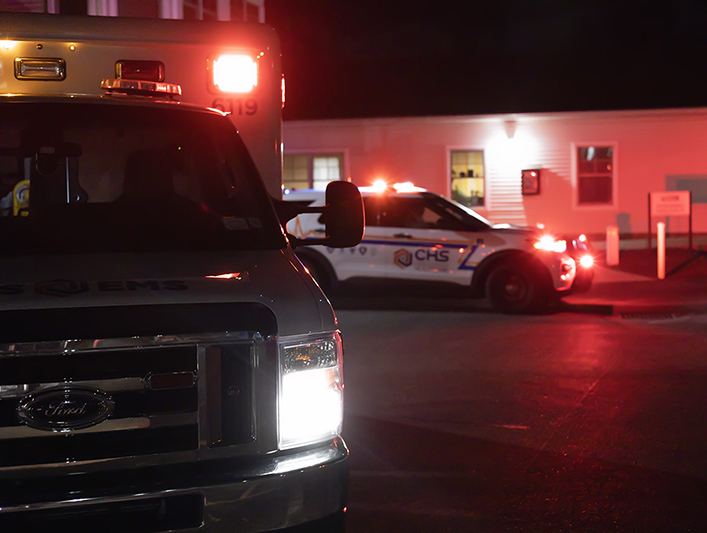Emergency Medical Services
Our Vehicles

Our fleet is comprised of 20 emergency response vehicles. All vehicles are New York State (NYS) certified, meaning they have been inspected by officials of NYS and carry all the equipment that is specified by the NYS requirement Part 800.
The majority of the time, our ambulances are setup as “ALS” (advanced life support), staffed with at least one paramedic to treat the patient. Occasionally, we will setup “BLS” ambulances (basic life support), staffed with an EMT who respond with a paramedic fly car in the event advanced care is needed.
When you dial 911 and CHS Healthcare responds, the vehicle(s) that come to your aid may vary based on our staffing levels, your location, and the seriousness of the injury/illness.
Our Vehicles
Our fleet is comprised of 20 emergency response vehicles. All vehicles are New York State (NYS) certified, meaning they have been inspected by officials of NYS and carry all the equipment that is specified by the NYS requirement Part 800.
The majority of the time, our ambulances are setup as “ALS” (advanced life support), staffed with at least one paramedic to treat the patient. Occasionally, we will setup “BLS” ambulances (basic life support), staffed with an EMT who respond with a paramedic fly car in the event advanced care is needed.
When you dial 911 and CHS Healthcare responds, the vehicle(s) that come to your aid may vary based on our staffing levels, your location, and the seriousness of the injury/illness.
Your Medical Care
EMT (BLS) & PARAMEDIC (ALS)
The in-charge medic caring for you on an EMS call is certified as either an Emergency Medical Technician (EMT) or Paramedic. There are two levels of care provided by an ambulance in Monroe County:

Basic Life Support (BLS)
BLS is handled by a NYS certified EMT who evaluates and treats the patient at the scene and en route to the hospital. In New York State, EMTs are trained to handle a variety of patient symptoms, illnesses and injury including bleeding, falls/trauma, oxygen administration and more. All medics are certified to use an AED (automated external cardiac defibrillator), units used on patients who are in cardiac arrest to “shock” their hearts into a normal rhythm. Basic EMTs are also all trained in the administration of Epi-Pens, Aspirin, Nitrogylcerin and Albuterol which can help save a patient’s life if they are experiencing certain symptoms.
Advanced Life Support (ALS)
ALS is handled by NYS certified paramedics. The ALS program at HVA began service in 1975. This service requires the greatest amount of medical training for our members. Paramedics are required to attend extensive classroom, hospital-based, and field-based training (usually 1,500+ hours).
Paramedics respond on life threatening (or potentially life threatening) emergencies as well as other serious calls. They assist in caring for the seriously injured or ill patients. Any emergency call that involves a life-threatening situation will have a paramedic respond to it.
Paramedics at CHS Healthcare are Trained to:
- Start IV or IO access (intravenous or intraosseous)
- Administer advanced medications – over 25 different drugs
- Provide advanced respiratory care – CPAP, intubation, orogastric tubes, surgical airway, RSI
- Diagnose and treat cardiac rhythm disorders
- Manage & oversee primary care for patients in cardiac and respiratory arrest
- Treat life threatening traumatic injury
- Interpret advanced cardiac ECG’s (12-lead) – identifying life threatening heart attacks
- Diagnose acute stroke symptoms
Several paramedics at CHS Healthcare have also completed the Rapid Sequence Induction (RSI) Program, enabling them to sedate, paralyze, and perform intubation on patients that are in severe need of assisted breathing through the use of an Endotrachael (ET) Tube.
Basic Life Support (BLS)
BLS is handled by a NYS certified EMT who evaluates and treats the patient at the scene and en route to the hospital. In New York State, EMTs are trained to handle a variety of patient symptoms, illnesses and injury including bleeding, falls/trauma, oxygen administration and more. All medics are certified to use an AED (automated external cardiac defibrillator), units used on patients who are in cardiac arrest to “shock” their hearts into a normal rhythm. Basic EMTs are also all trained in the administration of Epi-Pens, Aspirin, Nitrogylcerin and Albuterol which can help save a patient’s life if they are experiencing certain symptoms.
Advanced Life Support (ALS)
ALS is handled by NYS certified paramedics. The ALS program at HVA began service in 1975. This service requires the greatest amount of medical training for our members. Paramedics are required to attend extensive classroom, hospital-based, and field-based training (usually 1,500+ hours).
Paramedics respond on life threatening (or potentially life threatening) emergencies as well as other serious calls. They assist in caring for the seriously injured or ill patients. Any emergency call that involves a life-threatening situation will have a paramedic respond to it.
Paramedics at CHS Healthcare are Trained to:
- Start IV or IO access (intravenous or intraosseous)
- Administer advanced medications – over 25 different drugs
- Provide advanced respiratory care – CPAP, intubation, orogastric tubes, surgical airway, RSI
- Diagnose and treat cardiac rhythm disorders
- Manage & oversee primary care for patients in cardiac and respiratory arrest
- Treat life threatening traumatic injury
- Interpret advanced cardiac ECG’s (12-lead) – identifying life threatening heart attacks
- Diagnose acute stroke symptoms
Several paramedics at CHS Healthcare have also completed the Rapid Sequence Induction (RSI) Program, enabling them to sedate, paralyze, and perform intubation on patients that are in severe need of assisted breathing through the use of an Endotrachael (ET) Tube.
During Transport

The level of care (BLS or ALS) you receive during transport will depend on your symptoms and the necessary care provided by the ambulance crew. Generally, there will be one primary medic taking care of you who may be assisted by another medic or a trainee who is learning to care for patients. If you’re being treated by a paramedic, he/she may wish to start an IV on you during transport in order to allow for administration of medications by both EMS and the hospital staff. Our medics work to make you as comfortable as possible during transport to the hospital.
We currently are only able to transport patients to a local emergency department. Unfortunately, we cannot transport to urgent care centers at this time. The choice of which hospital we transport to is primarily up to the patient. We can provide basic guidance and information on the various hospitals however the ultimate decision lays with the patient.
During Transport
The level of care (BLS or ALS) you receive during transport will depend on your symptoms and the necessary care provided by the ambulance crew. Generally, there will be one primary medic taking care of you who may be assisted by another medic or a trainee who is learning to care for patients. If you’re being treated by a paramedic, he/she may wish to start an IV on you during transport in order to allow for administration of medications by both EMS and the hospital staff. Our medics work to make you as comfortable as possible during transport to the hospital.
We currently are only able to transport patients to a local emergency department. Unfortunately, we cannot transport to urgent care centers at this time. The choice of which hospital we transport to is primarily up to the patient. We can provide basic guidance and information on the various hospitals however the ultimate decision lays with the patient.
At The Hospital
Upon arrival at the hospital, the crew will take the patient to the “triage” area specifically for patients arriving by ambulance. The medic will provide information to the triage nurse who will then assign a place for the patient within the emergency department. The assignment may be to an open bed or to the waiting room. After the patient has been transferred to the hospital, the medic in charge completes an electronic patient chart that becomes part of the patient’s medical record.
Mutual Aid
We are extremely proud of our call coverage percentage. However, there are times when our agency becomes extremely busy and resources are temporarily taxed. The balance of the calls (2%) will be handled by a neighboring EMS or commercial ambulance agency. There is a slight chance that you may be cared for by one of these other agencies, including Brighton Ambulance, AMR, Rush Volunteer Ambulance, RIT Ambulance, Pittsford Ambulance, Monroe Ambulance, or Honeoye Falls-Mendon Ambulance. Likewise, CHS Healthcare responds to other towns and counties, assisting when they become busy.




